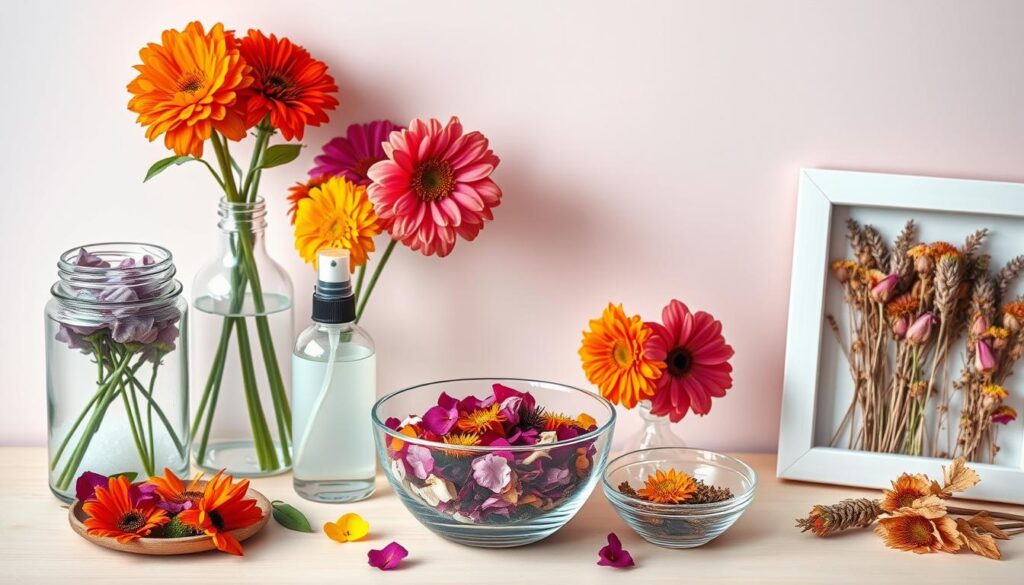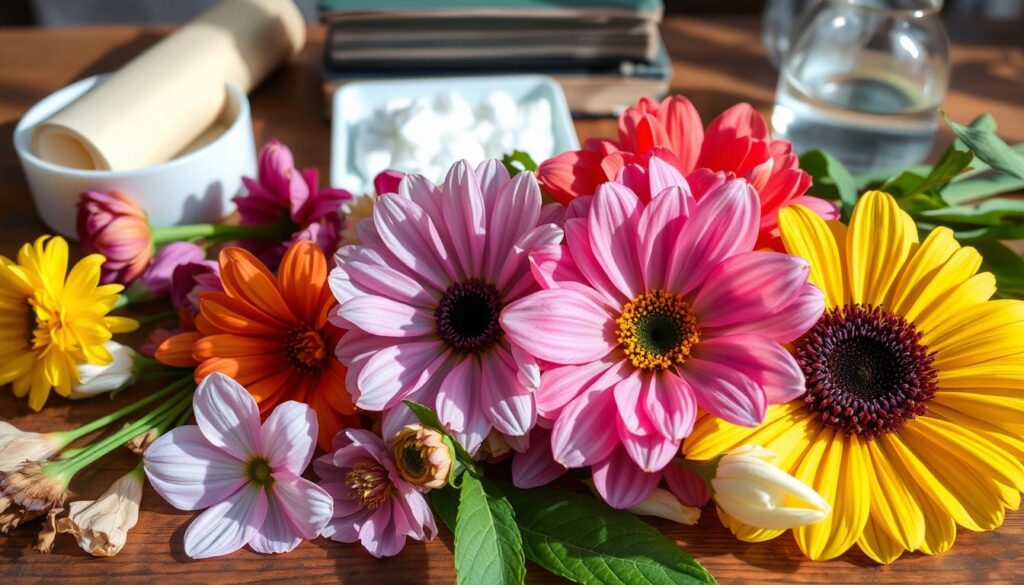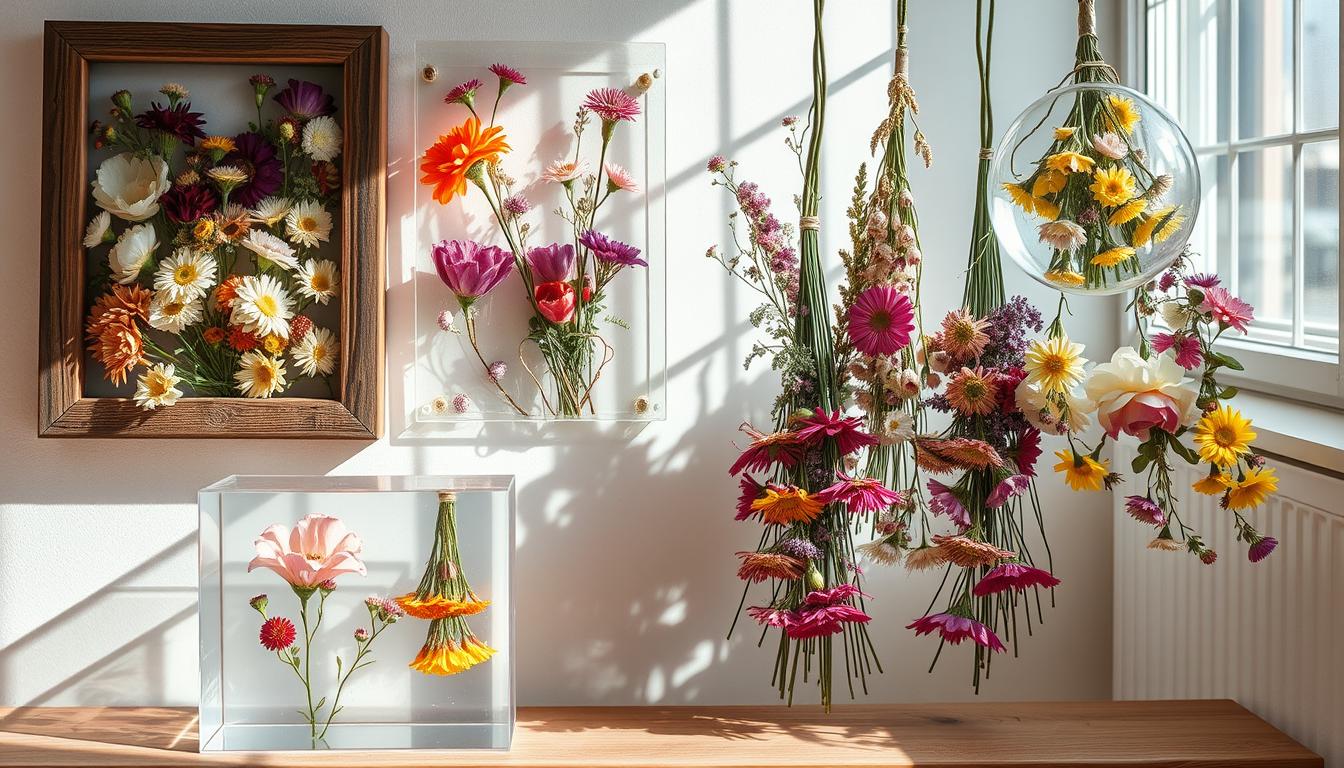Preserving flowers has become an art form. It lets people keep beautiful memories for months or years. There are many ways to keep cherished blooms alive longer than they naturally would.
Whether you want to make keepsakes, decorate your home, or save special memories, there are options for you. Long-lasting flower methods are perfect for flower lovers.
Flowers hold deep emotional value. This makes preserving them very appealing. You can keep wedding bouquets or garden favorites looking beautiful for a long time.
Each preservation method has its own benefits and challenges. This lets you pick the best way to keep your flowers looking great.
The world of flower preservation is full of options. You can choose from air drying to resin encapsulation. These methods turn delicate petals into lasting keepsakes that show off their original beauty.
Whether you love crafting or just want to keep a special memory, there’s a method for you. Flower preservation is for everyone.
Key Takeaways
- Multiple flower preservation techniques exist for different preferences
- Proper preservation can extend flower life for months or years
- Each method requires specific tools and careful attention to detail
- Flower selection plays a crucial role in successful preservation
- Preserved flowers can be used for various decorative and sentimental purposes
Understanding Flower Preservation: A Complete Guide
Flower preservation has become more popular. It’s now a way to keep memories alive. This guide will show you how to keep flowers beautiful for years.
Preserving flowers is more than just keeping them. It’s about holding onto special moments. And creating art that tells your story.
Why Preserve Flowers
There are many reasons to preserve flowers:
- Wedding bouquet remembrance
- Memorial tributes
- Commemorating special life events
- Creating personalized home decor
Best Time to Preserve Flowers
When you preserve flowers, timing is key. Choose flowers that are:
- Partially bloomed
- Free from moisture
- At peak freshness
- Without significant blemishes
“The secret to perfect flower preservation lies in selecting the right bloom at the right moment.”
Types of Flowers Suitable for Preservation
Not all flowers are created equal when it comes to preservation. Some do better with certain methods:
| Flower Type | Preservation Method | Drying Time |
|---|---|---|
| Roses | Silica Gel | 2-3 weeks |
| Lavender | Air Drying | 7-10 days |
| Peonies | Resin Embedding | 4-6 weeks |
Preserving flowers takes patience, skill, and knowing each flower’s special needs.
How to Preserve Flowers Through Air Drying
Air drying flowers is a simple way to keep your favorite blooms for a long time. It’s easy, affordable, and doesn’t need much equipment.
Air drying flowers captures the beauty of your favorite blossoms. It takes about two to three weeks. It works best with certain types of flowers.
Step-by-Step Air Drying Process
- Select flowers at their peak bloom, just as they begin to open
- Remove excess leaves from the stems
- Cut stems to at least 6 inches long
- Group flowers in small clusters of three
- Secure clusters with string or rubber bands
- Hang flowers upside down in a cool, dark, dry space
Tips for Better Air-Dried Results
- Maintain 6 inches of space between flower clusters
- Choose a location with good air circulation
- Avoid direct sunlight to preserve color
- Select sturdy flowers like hydrangeas, roses, and grasses
Common Air Drying Mistakes to Avoid
| Mistake | Consequence | Solution |
|---|---|---|
| Drying overmature flowers | Poor preservation quality | Select flowers just beginning to open |
| Insufficient air circulation | Mold growth | Ensure proper spacing between clusters |
| Exposing to direct sunlight | Color fading | Choose a dark, cool drying location |
“Patience is key in natural flower preservation. Allow your flowers time to dry completely for the best results.” – Botanical Preservation Expert
By following these guidelines, you can make beautiful, lasting floral keepsakes. They will keep much of their original charm and delicacy.
The Art of Pressing Flowers
Flower pressing turns delicate blooms into lasting memories. This ancient craft has been loved by artists and nature lovers for thousands of years. It’s a special way to keep the beauty of flowers alive.
Choosing the right flowers is key for successful pressing. Ideal candidates include single-layer petal flowers like:
- Cosmos
- Daisies
- Snapdragons
- Violets
“The secret to perfect pressed flowers lies in careful selection and precise technique.”
To get the best results, you need the right tools. Essential supplies for pressed flower preservation include:
- Flower press
- Tweezers
- Garden shears
- Cardboard sheets
- Drying plates
- Lining paper
The pressing process takes 2 to 3 weeks. Experts say to start right after cutting flowers for the best quality. Use clean white paper and make sure flowers are dry to avoid mold.
With the right steps, pressed flowers can last decades. They become treasured keepsakes or beautiful parts of arts and crafts. Whether you’re a hobbyist or an artist, learning flower pressing opens up endless creative doors.
Silica Gel Method for Perfect Preservation
Silica gel flower preservation is a top-notch way to keep flowers looking great. It’s one of the best methods to preserve flowers without losing their natural beauty.
The secret to 3D flower drying is silica gel’s ability to soak up moisture. This method keeps flowers looking like they just bloomed, with all their details intact.
Essential Materials for Preservation
- High-quality silica gel crystals
- Airtight container with lid
- Soft paintbrush
- Protective gloves
- Dust mask
“Preservation is an art, and silica gel is your perfect paintbrush for capturing floral beauty.” – Botanical Preservation Expert
Drying Process and Recommendations
The silica gel preservation process usually takes 1-2 weeks. To get the best results, pay attention to a few important steps:
- Select fresh flowers at peak bloom
- Remove excess moisture before drying
- Completely cover flowers with silica gel
- Store in a cool, dry location
Experts suggest checking the flowers often. They should feel dry and stiff when they’re done. For flowers like roses and hydrangeas, extra care is key for perfect preservation.
Storage and Maintenance
After drying, keep your flowers in a dark, cool spot. Silica gel-preserved flowers can stay beautiful for years if kept away from sunlight and humidity.
Remember to wear protective gear like dust masks and gloves when working with silica gel. This prevents irritation from the fine particles.
Microwave Drying Technique
Microwave flower drying is a quick and new way to preserve flowers. It changes how we keep flowers fresh. This method dries flowers fast, keeping their shape and colors bright.
This technique is great for drying small flowers like pansies and daisies. They usually need 1 to 2 minutes in the microwave.
“Precision is key in microwave flower drying – every second counts in preserving your botanical treasures.”
- Recommended flowers for microwave drying:
- Roses
- Chrysanthemums
- Tulips
- Pansies
To dry flowers in the microwave, you need the right stuff. Gardeners should get:
- Silica gel
- Paper towels
- Microwave-safe plates
- Clean, fresh flowers
Drying time depends on the flower. Thinner flowers dry quicker, while roses and thicker ones might take up to 3 minutes. It’s important to check every 30 seconds to avoid burning.
| Flower Type | Drying Time | Special Considerations |
|---|---|---|
| Pansies | 1-2 minutes | Thin petals, quick drying |
| Roses | 2-3 minutes | Thicker petals, slower drying |
| Chrysanthemums | 2 minutes | Medium thickness, moderate drying |
For better microwave flower drying, use two paper towels to soak up moisture. Place flowers carefully so they don’t overlap, which can cause uneven drying.
Using Resin for Long-lasting Flower Preservation
Resin flower preservation is a magical way to keep delicate blooms alive forever. It turns flowers into stunning, crystal-clear keepsakes. These memorials capture the beauty of your favorite flowers for years.
To preserve flowers in resin, you need to be precise. This ensures your flowers stay beautiful and well-preserved.
Types of Resin for Flower Preservation
- Deep pour epoxy resin
- Casting resin
- UV-resistant clear resin
- Art-grade transparent resin
Choosing the right resin is key. Look for clarity, curing time, and how well it works with flowers.
| Resin Type | Curing Time | Best Use |
|---|---|---|
| Deep Pour Epoxy | 72 hours | Thick embedments |
| Casting Resin | 48 hours | Detailed flower arrangements |
| UV-Resistant Resin | 24-36 hours | Outdoor displays |
Safety Measures When Working with Resin
Working with resin needs strict safety rules to protect you.
- Work in a well-ventilated area
- Wear protective gear:
- Respirator mask
- Protective gloves
- Safety goggles
- Maintain a clean workspace
- Follow precise mixing ratios
Pro Tip: Ensure flowers are completely dry before encasing flowers in resin to prevent moisture-related deterioration.
Preserving flowers in resin takes patience and precision. With the right techniques, you can make stunning keepsakes. These keepsakes will keep memories alive for generations.
Oven Drying Method
The oven drying method is a fast way to preserve flowers. It’s not perfect for keeping flowers looking great, but it’s great for making aromatic potpourri and decorative items.
To dry flowers well, you need to prepare them right and control the oven’s temperature. Use a convection oven at 40°C for the best results. It usually takes 3-4 hours, but it depends on the flower’s size and how wet it is.
- Select fresh flowers at peak bloom
- Ensure flowers are clean and free from moisture
- Use low, consistent temperature settings
- Monitor flowers closely to prevent burning
“Patience and precision are key to creating beautiful oven-dried flowers.” – Botanical Preservation Expert
Each flower type dries differently in the oven. Flowers with bright colors like purple, blue, orange, and pink keep their colors best. Thin-stemmed flowers dry better than thick, wet ones.
| Flower Type | Drying Time | Color Retention |
|---|---|---|
| Delphinium | 3-4 hours | Excellent |
| Daisies | 2-3 hours | Very Good |
| Roses | 4-5 hours | Good |
Pro tip for oven-dried flowers: Keep your dried flowers in a dark, cool place at room temperature. This helps keep them looking good and prevents color loss.
Essential Tools and Materials for Preservation
Starting your flower preservation journey needs the right supplies and tools. Whether you’re new or experienced, the right equipment is key to success. Flower preservation is both an art and a science, requiring careful preparation.
Basic Equipment for Flower Preservation
Every flower lover needs a basic set of tools. Here are the must-haves:
- Sharp pruning shears for clean stem cuts
- Drying racks or hanging lines
- Silica gel containers
- Pressing books or flower press
- Protective gloves
- Clean, dry storage containers
Advanced Tools for Serious Preservationists
If you want to take your craft to the next level, consider these advanced tools:
- Dehydrator with adjustable temperature settings
- Professional flower press
- Resin casting kit
- Digital hygrometer for moisture control
- Precision cutting tools
“The right tools transform flower preservation from a simple hobby to an art form.”
When choosing your supplies, focus on quality and durability. Choose tools that help keep your flowers beautiful through different preservation methods.
Color Preservation Tips and Techniques

Keeping dried flowers bright requires careful steps. Preserving flower color is an art that needs precision and smart drying methods.
“The secret to vibrant dried flowers lies in understanding their delicate nature and protecting their original beauty.” – Flower Preservation Expert
Start by protecting flower colors with smart techniques. Sunlight can quickly fade flower colors. So, picking the right drying method is key.
- Keep flowers away from direct sunlight during drying
- Choose preservation methods that minimize color degradation
- Select flowers at their peak color intensity
- Use protective sprays to lock in natural colors
Different drying methods affect flower color in different ways. Air drying, silica gel, and pressing each have their own benefits for keeping colors bright.
| Preservation Method | Color Retention Effectiveness | Recommended Flowers |
|---|---|---|
| Air Drying | Moderate | Roses, Lavender, Statice |
| Silica Gel | High | Delicate Petals, Dahlias |
| Pressing | Low to Moderate | Thin Petaled Flowers |
Experts suggest using acrylic sealer spray to keep colors bright. A light coat can make your dried flowers last longer.
Timing is everything. Pick flowers at their best and start preserving right away. This way, your dried flowers will stay vibrant and beautiful.
Storage Solutions for Preserved Flowers
Storing dried flowers needs careful attention to keep their beauty. The right storage keeps your flower arrangements looking great for years. It’s all about preserving their delicate beauty.
Ideal Storage Conditions
Creating the perfect environment for storing dried flowers involves several key considerations:
- Maintain a cool temperature below 70°F (21°C)
- Keep flowers away from direct sunlight
- Choose dark, dry storage spaces
- Use acid-free containers
Protecting from Environmental Factors
Environmental elements can quickly deteriorate your preserved flowers. Implement these protective strategies:
- Use airtight containers to prevent dust accumulation
- Add silica gel packets to control moisture
- Inspect stored flowers regularly for signs of mold
| Storage Method | Recommended Duration | Best For |
|---|---|---|
| Archival Boxes | Up to 5 years | Delicate pressed flowers |
| Glass Display Cases | 2-3 years | Larger dried arrangements |
| Sealed Plastic Containers | 1-2 years | Small flower collections |
“Preservation is an art, and storage is its guardian.” – Flower Preservation Expert
With careful care, your dried flowers can be a cherished keepsake for years. Replace silica gel packets every few months. Check for moisture to keep your flower arrangements preserved.
Creative Ways to Display Preserved Flowers
Transformed preserved flower arrangements offer countless opportunities to showcase your cherished botanical memories. Whether you’ve carefully dried blooms from a special occasion or collected meaningful petals, displaying dried flowers can become an art form. It captures both emotion and aesthetic appeal.
Innovative display techniques can transform your preserved flowers into stunning decorative pieces. Consider these creative approaches:
- Glass display boxes with elegant mounting
- Floating frames highlighting delicate flower structures
- Decorative wall art with carefully arranged pressed specimens
- Custom resin jewelry featuring miniature floral designs
- Vintage-inspired shadow boxes with multiple botanical elements
Statistics reveal fascinating trends in preserved flower displays. Approximately 45% of individuals choose to frame their preserved bouquets as wall art. This integrates sentimental botanical memories into home decor.
| Display Method | Popularity | Estimated Cost |
|---|---|---|
| Glass Display Boxes | 60% | $200-$500 |
| Framed Wall Art | 45% | $295-$998 |
| Mantelpiece Displays | 40% | $50-$150 |
| Resin Encapsulation | 25% | $480-$1310 |
Pro tip: When creating preserved flower arrangements, consider color harmony, texture variation, and personal significance. Each display tells a unique story. It transforms delicate botanicals into lasting artistic expressions.
“Preserved flowers are not just decorations—they’re captured moments of beauty, frozen in time.”
DIY enthusiasts can explore numerous techniques for displaying their cherished dried flowers. From simple frames to intricate resin designs, the key is to select a method that resonates with your personal style. It should also preserve the emotional connection to the original blooms.
Troubleshooting Common Preservation Problems
Flower preservation can be tricky, and many enthusiasts face challenges. They try to keep their blooms beautiful. Knowing common issues helps prevent and fix problems before they damage delicate arrangements.

Preserving flowers needs careful attention and understanding of challenges. Here are key issues and solutions:
- Mold Growth: Often caused by inadequate drying or high humidity
- Color Fading: Typically results from direct sunlight exposure
- Petal Loss: Can occur with improper handling or incorrect preservation techniques
- Structural Damage: Happens when flowers are not dried correctly
“Prevention is always better than cure in flower preservation”
To fix dried flower problems, specific strategies are needed. For mold, ensure complete dryness and store in low-humidity places. To keep colors, place flowers away from direct sunlight.
| Problem | Prevention | Solution |
|---|---|---|
| Mold | Proper drying | Use silica gel, control humidity |
| Color Fading | Avoid sunlight | Store in dark, cool space |
| Structural Damage | Gentle handling | Use appropriate preservation method |
Professional tip: Regular inspection helps catch preservation issues early, allowing timely intervention and maintaining flower quality.
Conclusion
Exploring flower preservation techniques is a beautiful way to keep cherished blooms alive. Methods like air drying and resin encapsulation turn delicate petals into lasting keepsakes. Roses, lavender, and chrysanthemums are top picks for preservation, offering stunning results.
The process of preserving flowers requires patience and precision. Techniques like silica gel drying take 1-2 weeks, while pressing methods need 2-3 weeks. It’s important to protect your preserved flowers from sunlight and clean them gently to keep their beauty and colors bright.
Mastering flower preservation is about creating lasting memories. This guide helps you turn fleeting floral moments into treasures. Whether you choose professional services or DIY methods, you can keep special botanical memories alive.
Starting your flower preservation journey? Remember, it’s all about experimenting and being creative. Each flower has its own story, and with the right technique, you can preserve those stories for years.

